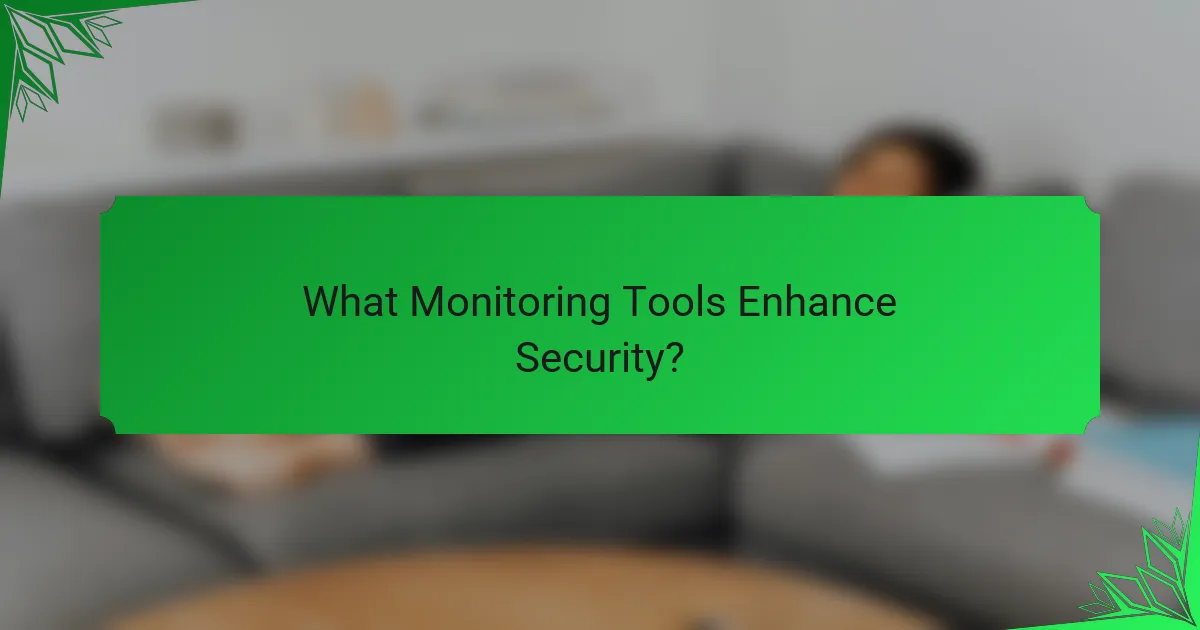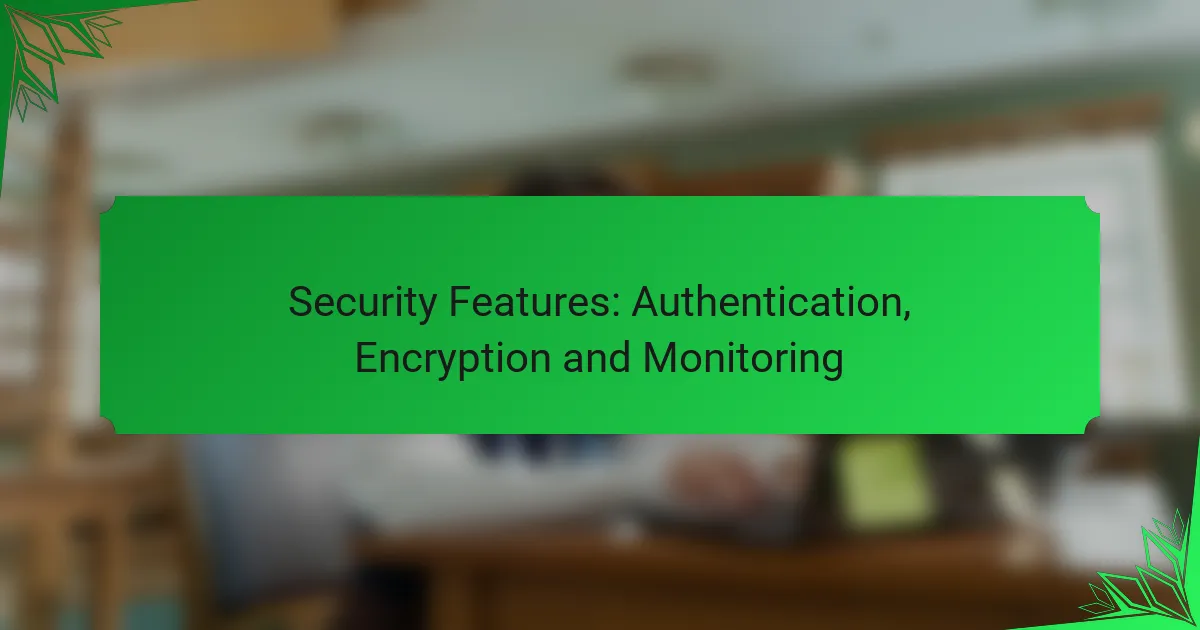In today’s digital landscape, robust security features such as authentication, encryption, and monitoring are essential for protecting sensitive information. Authentication methods verify user identities through techniques like two-factor and biometric authentication, while encryption safeguards data by rendering it unreadable without the appropriate keys. Additionally, monitoring tools provide real-time insights into network activity, helping organizations detect threats and maintain compliance.

What Are the Key Authentication Methods?
Key authentication methods enhance security by verifying user identities through various techniques. These methods include two-factor authentication, biometric authentication, OAuth protocol, single sign-on, and multi-factor authentication, each offering unique benefits and considerations.
Two-Factor Authentication
Two-factor authentication (2FA) adds an extra layer of security by requiring two forms of verification before granting access. Typically, this involves something the user knows, like a password, and something the user has, such as a mobile device receiving a one-time code.
Implementing 2FA significantly reduces the risk of unauthorized access, especially in environments handling sensitive information. Users should be aware of potential pitfalls, such as losing access to their second factor if their device is lost or stolen.
Biometric Authentication
Biometric authentication uses unique physical characteristics, such as fingerprints, facial recognition, or iris scans, to verify identity. This method is increasingly popular due to its convenience and the difficulty of replicating biometric traits.
While biometric systems offer high security, they also raise privacy concerns and require careful handling of biometric data. Users should ensure that their devices are equipped with secure biometric systems that comply with relevant regulations.
OAuth Protocol
The OAuth protocol allows users to grant third-party applications limited access to their resources without sharing passwords. It is commonly used for social media logins and enables secure interactions between different services.
When implementing OAuth, it is crucial to understand the scopes of access granted to third parties. Users should regularly review and revoke permissions for applications they no longer use to maintain security.
Single Sign-On
Single sign-on (SSO) simplifies the user experience by allowing access to multiple applications with one set of credentials. This method reduces password fatigue and enhances security by centralizing authentication.
However, SSO can create a single point of failure; if the SSO account is compromised, all linked accounts may be at risk. Organizations should implement strong security measures, such as 2FA, alongside SSO to mitigate this risk.
Multi-Factor Authentication
Multi-factor authentication (MFA) extends beyond two-factor authentication by requiring two or more verification methods. This could include a combination of passwords, security tokens, and biometric verification.
MFA significantly enhances security, especially for sensitive applications. Users should be aware of the balance between security and convenience, as more factors can complicate the login process. Regularly updating authentication methods and educating users on best practices can further strengthen security measures.

How Does Encryption Protect Data?
Encryption protects data by converting it into a format that is unreadable without a specific key or password. This process ensures that sensitive information remains confidential, even if intercepted or accessed by unauthorized individuals.
Symmetric Encryption
Symmetric encryption uses a single key for both encryption and decryption. This means that both the sender and receiver must securely share the same key, which can be a challenge in terms of security and key management. Common algorithms include AES and DES, which are widely used for their speed and efficiency.
One key consideration is that if the key is compromised, all data encrypted with that key is at risk. Therefore, it is crucial to implement strong key management practices and regularly update keys to enhance security.
Asymmetric Encryption
Asymmetric encryption employs a pair of keys: a public key for encryption and a private key for decryption. This method allows users to share their public key openly while keeping the private key secret, significantly improving security. RSA and ECC are popular algorithms in this category.
This approach eliminates the need for key sharing, reducing the risk of interception. However, asymmetric encryption is generally slower than symmetric encryption, making it less suitable for encrypting large amounts of data directly.
End-to-End Encryption
End-to-end encryption ensures that data is encrypted on the sender’s device and only decrypted on the recipient’s device. This means that even intermediaries, such as service providers, cannot access the plaintext data. Applications like WhatsApp and Signal utilize this method to protect user communications.
While end-to-end encryption provides robust security, it can complicate data recovery and management for service providers. Users should be aware of this trade-off when choosing applications that implement this feature.
Data-at-Rest Encryption
Data-at-rest encryption protects stored data, such as files on a hard drive or databases, from unauthorized access. This is crucial for safeguarding sensitive information in case of physical theft or data breaches. Solutions often use symmetric encryption algorithms to secure the data.
Implementing data-at-rest encryption is essential for compliance with regulations like GDPR or HIPAA, which mandate the protection of personal and sensitive information. Organizations should regularly audit their encryption practices to ensure effectiveness.
Data-in-Transit Encryption
Data-in-transit encryption secures data as it moves across networks, preventing interception during transmission. Protocols like TLS (Transport Layer Security) are commonly used to encrypt web traffic, ensuring that sensitive information remains confidential while being transferred.
It is vital to implement data-in-transit encryption for any communication involving sensitive data, such as online banking or e-commerce transactions. Regularly updating encryption protocols and using strong certificates can help maintain security against evolving threats.

What Monitoring Tools Enhance Security?
Monitoring tools are essential for enhancing security by providing real-time insights into network activity, identifying potential threats, and ensuring compliance with regulations. Effective monitoring can help organizations detect breaches early and respond promptly to mitigate risks.
Intrusion Detection Systems
Intrusion Detection Systems (IDS) monitor network traffic for suspicious activity and potential threats. They can be classified into two main types: network-based IDS, which analyzes traffic across the entire network, and host-based IDS, which focuses on individual devices. Implementing an IDS can significantly reduce response times to security incidents.
When selecting an IDS, consider factors such as detection capabilities, ease of integration with existing systems, and alerting mechanisms. Regular updates and tuning are crucial to minimize false positives and ensure effective threat detection.
Security Information and Event Management
Security Information and Event Management (SIEM) systems aggregate and analyze security data from various sources to provide a comprehensive view of an organization’s security posture. SIEM tools facilitate real-time monitoring, incident response, and compliance reporting by correlating events and identifying anomalies.
When implementing a SIEM solution, prioritize scalability and the ability to integrate with other security tools. Regularly review and refine alert thresholds to reduce noise and focus on genuine threats. Many organizations find it beneficial to conduct periodic audits of their SIEM configurations to ensure optimal performance.
Network Monitoring Tools
Network monitoring tools track the performance and health of network infrastructure, helping to identify bottlenecks, outages, and security threats. These tools can provide insights into bandwidth usage, device status, and overall network performance, allowing for proactive management.
Choose network monitoring solutions that offer real-time alerts and customizable dashboards for easy visualization of data. Consider tools that support integration with other security systems to enhance overall monitoring capabilities. Regularly analyze network traffic patterns to identify any unusual behavior that could indicate a security issue.
Application Performance Monitoring
Application Performance Monitoring (APM) tools focus on the performance and availability of software applications. They help identify issues such as slow response times or application crashes, which can impact user experience and security. APM tools can also monitor user interactions to detect potential security threats.
When selecting an APM solution, look for features such as transaction tracing, real-user monitoring, and integration with incident management systems. Regularly review application performance metrics to identify trends and address potential vulnerabilities before they can be exploited.

What Are the Best Practices for Security Features?
Best practices for security features include implementing robust authentication methods, ensuring data encryption, and establishing continuous monitoring systems. These practices help protect sensitive information from unauthorized access and potential breaches.
Regular Software Updates
Regular software updates are crucial for maintaining security features. They patch vulnerabilities that could be exploited by attackers, ensuring that systems remain resilient against new threats. Schedule updates at least monthly, or more frequently if critical vulnerabilities are discovered.
Consider using automated update tools to streamline the process. This reduces the risk of human error and ensures that all software, including operating systems and applications, is consistently updated.
Employee Training Programs
Employee training programs are essential for enhancing security awareness among staff. Regular training sessions should cover topics such as recognizing phishing attempts, safe password practices, and the importance of data protection. Aim for at least two training sessions per year to keep security top-of-mind.
Incorporate real-life scenarios and simulations to make training engaging and practical. This hands-on approach helps employees understand the implications of security breaches and reinforces their role in safeguarding company assets.
Access Control Policies
Access control policies define who can access specific resources within an organization. Implementing the principle of least privilege ensures that employees only have access to the information necessary for their roles. Regularly review access rights to adapt to changes in job functions or personnel.
Utilize role-based access control (RBAC) to streamline permissions management. This method categorizes users based on their job functions, simplifying the process of granting and revoking access while enhancing overall security.
